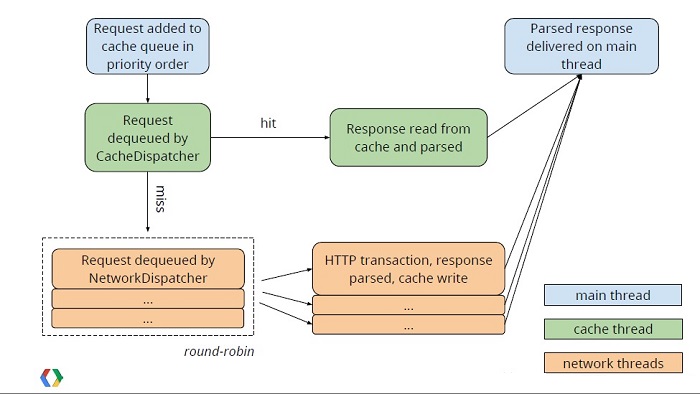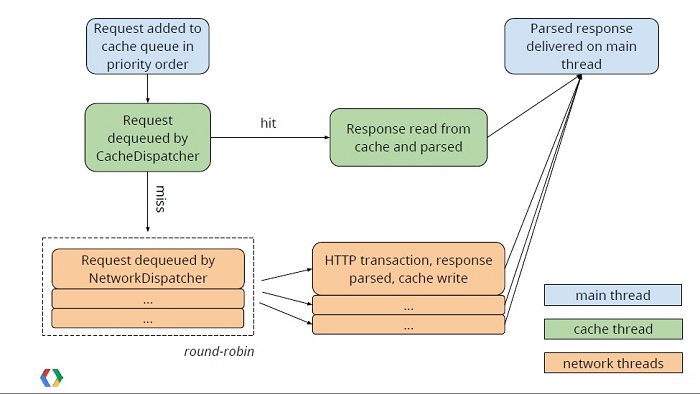| 经过前三篇文章的学习,Volley的用法我们已经掌握的差不多了,但是对于Volley的工作原理,恐怕有很多朋友还不是很清楚。因此,本篇文章中我们就来一起阅读一下Volley的源码,将它的工作流程整体地梳理一遍。同时,这也是Volley系列的最后一篇文章了。
其实,Volley的官方文档中本身就附有了一张Volley的工作流程图,如下图所示。

多数朋友突然看到一张这样的图,应该会和我一样,感觉一头雾水吧?没错,目前我们对Volley背后的工作原理还没有一个概念性的理解,直接就来看这张图自然会有些吃力。不过没关系,下面我们就去分析一下Volley的源码,之后再重新来看这张图就会好理解多了。
说起分析源码,那么应该从哪儿开始看起呢?这就要回顾一下Volley的用法了,还记得吗,使用Volley的第一步,首先要调用Volley.newRequestQueue(context)方法来获取一个RequestQueue对象,那么我们自然要从这个方法开始看起了,代码如下所示:
public static RequestQueue newRequestQueue(Context context) {
return newRequestQueue(context, null);
} |
这个方法仅仅只有一行代码,只是调用了newRequestQueue()的方法重载,并给第二个参数传入null。那我们看下带有两个参数的newRequestQueue()方法中的代码,如下所示:
public static RequestQueue newRequestQueue(Context context, HttpStack stack) {
File cacheDir = new File(context.getCacheDir(), DEFAULT_CACHE_DIR);
String userAgent = "volley/0";
try {
String packageName = context.getPackageName();
PackageInfo info = context.getPackageManager().getPackageInfo(packageName, 0);
userAgent = packageName + "/" + info.versionCode;
} catch (NameNotFoundException e) {
}
if (stack == null) {
if (Build.VERSION.SDK_INT >= 9) {
stack = new HurlStack();
} else {
stack = new HttpClientStack(AndroidHttpClient.newInstance(userAgent));
}
}
Network network = new BasicNetwork(stack);
RequestQueue queue = new RequestQueue(new DiskBasedCache(cacheDir), network);
queue.start();
return queue;
} |
可以看到,这里在第10行判断如果stack是等于null的,则去创建一个HttpStack对象,这里会判断如果手机系统版本号是大于9的,则创建一个HurlStack的实例,否则就创建一个HttpClientStack的实例。实际上HurlStack的内部就是使用HttpURLConnection进行网络通讯的,而HttpClientStack的内部则是使用HttpClient进行网络通讯的,这里为什么这样选择呢?可以参考我之前翻译的一篇文章Android访问网络,使用HttpURLConnection还是HttpClient?
创建好了HttpStack之后,接下来又创建了一个Network对象,它是用于根据传入的HttpStack对象来处理网络请求的,紧接着new出一个RequestQueue对象,并调用它的start()方法进行启动,然后将RequestQueue返回,这样newRequestQueue()的方法就执行结束了。
那么RequestQueue的start()方法内部到底执行了什么东西呢?我们跟进去瞧一瞧:
public void start() {
stop(); // Make sure any currently running dispatchers are stopped.
// Create the cache dispatcher and start it.
mCacheDispatcher = new CacheDispatcher(mCacheQueue, mNetworkQueue, mCache, mDelivery);
mCacheDispatcher.start();
// Create network dispatchers (and corresponding threads) up to the pool size.
for (int i = 0; i < mDispatchers.length; i++) {
NetworkDispatcher networkDispatcher = new NetworkDispatcher(mNetworkQueue, mNetwork,
mCache, mDelivery);
mDispatchers[i] = networkDispatcher;
networkDispatcher.start();
}
} |
这里先是创建了一个CacheDispatcher的实例,然后调用了它的start()方法,接着在一个for循环里去创建NetworkDispatcher的实例,并分别调用它们的start()方法。这里的CacheDispatcher和NetworkDispatcher都是继承自Thread的,而默认情况下for循环会执行四次,也就是说当调用了Volley.newRequestQueue(context)之后,就会有五个线程一直在后台运行,不断等待网络请求的到来,其中CacheDispatcher是缓存线程,NetworkDispatcher是网络请求线程。
得到了RequestQueue之后,我们只需要构建出相应的Request,然后调用RequestQueue的add()方法将Request传入就可以完成网络请求操作了,那么不用说,add()方法的内部肯定有着非常复杂的逻辑,我们来一起看一下:
public <T> Request<T> add(Request<T> request) {
// Tag the request as belonging to this queue and add it to the set of current requests.
request.setRequestQueue(this);
synchronized (mCurrentRequests) {
mCurrentRequests.add(request);
}
// Process requests in the order they are added.
request.setSequence(getSequenceNumber());
request.addMarker("add-to-queue");
// If the request is uncacheable, skip the cache queue and go straight to the network.
if (!request.shouldCache()) {
mNetworkQueue.add(request);
return request;
}
// Insert request into stage if there's already a request with the same cache key in flight.
synchronized (mWaitingRequests) {
String cacheKey = request.getCacheKey();
if (mWaitingRequests.containsKey(cacheKey)) {
// There is already a request in flight. Queue up.
Queue<Request<?>> stagedRequests = mWaitingRequests.get(cacheKey);
if (stagedRequests == null) {
stagedRequests = new LinkedList<Request<?>>();
}
stagedRequests.add(request);
mWaitingRequests.put(cacheKey, stagedRequests);
if (VolleyLog.DEBUG) {
VolleyLog.v("Request for cacheKey=%s is in flight, putting on hold.", cacheKey);
}
} else {
// Insert 'null' queue for this cacheKey, indicating there is now a request in
// flight.
mWaitingRequests.put(cacheKey, null);
mCacheQueue.add(request);
}
return request;
}
} |
可以看到,在第11行的时候会判断当前的请求是否可以缓存,如果不能缓存则在第12行直接将这条请求加入网络请求队列,可以缓存的话则在第33行将这条请求加入缓存队列。在默认情况下,每条请求都是可以缓存的,当然我们也可以调用Request的setShouldCache(false)方法来改变这一默认行为。
OK,那么既然默认每条请求都是可以缓存的,自然就被添加到了缓存队列中,于是一直在后台等待的缓存线程就要开始运行起来了,我们看下CacheDispatcher中的run()方法,代码如下所示:
public class CacheDispatcher extends Thread {
……
@Override
public void run() {
if (DEBUG) VolleyLog.v("start new dispatcher");
Process.setThreadPriority(Process.THREAD_PRIORITY_BACKGROUND);
// Make a blocking call to initialize the cache.
mCache.initialize();
while (true) {
try {
// Get a request from the cache triage queue, blocking until
// at least one is available.
final Request<?> request = mCacheQueue.take();
request.addMarker("cache-queue-take");
// If the request has been canceled, don't bother dispatching it.
if (request.isCanceled()) {
request.finish("cache-discard-canceled");
continue;
}
// Attempt to retrieve this item from cache.
Cache.Entry entry = mCache.get(request.getCacheKey());
if (entry == null) {
request.addMarker("cache-miss");
// Cache miss; send off to the network dispatcher.
mNetworkQueue.put(request);
continue;
}
// If it is completely expired, just send it to the network.
if (entry.isExpired()) {
request.addMarker("cache-hit-expired");
request.setCacheEntry(entry);
mNetworkQueue.put(request);
continue;
}
// We have a cache hit; parse its data for delivery back to the request.
request.addMarker("cache-hit");
Response<?> response = request.parseNetworkResponse(
new NetworkResponse(entry.data, entry.responseHeaders));
request.addMarker("cache-hit-parsed");
if (!entry.refreshNeeded()) {
// Completely unexpired cache hit. Just deliver the response.
mDelivery.postResponse(request, response);
} else {
// Soft-expired cache hit. We can deliver the cached response,
// but we need to also send the request to the network for
// refreshing.
request.addMarker("cache-hit-refresh-needed");
request.setCacheEntry(entry);
// Mark the response as intermediate.
response.intermediate = true;
// Post the intermediate response back to the user and have
// the delivery then forward the request along to the network.
mDelivery.postResponse(request, response, new Runnable() {
@Override
public void run() {
try {
mNetworkQueue.put(request);
} catch (InterruptedException e) {
// Not much we can do about this.
}
}
});
}
} catch (InterruptedException e) {
// We may have been interrupted because it was time to quit.
if (mQuit) {
return;
}
continue;
}
}
}
} |
代码有点长,我们只挑重点看。首先在11行可以看到一个while(true)循环,说明缓存线程始终是在运行的,接着在第23行会尝试从缓存当中取出响应结果,如何为空的话则把这条请求加入到网络请求队列中,如果不为空的话再判断该缓存是否已过期,如果已经过期了则同样把这条请求加入到网络请求队列中,否则就认为不需要重发网络请求,直接使用缓存中的数据即可。之后会在第39行调用Request的parseNetworkResponse()方法来对数据进行解析,再往后就是将解析出来的数据进行回调了,这部分代码我们先跳过,因为它的逻辑和NetworkDispatcher后半部分的逻辑是基本相同的,那么我们等下合并在一起看就好了,先来看一下NetworkDispatcher中是怎么处理网络请求队列的,代码如下所示:
public class NetworkDispatcher extends Thread {
……
@Override
public void run() {
Process.setThreadPriority(Process.THREAD_PRIORITY_BACKGROUND);
Request<?> request;
while (true) {
try {
// Take a request from the queue.
request = mQueue.take();
} catch (InterruptedException e) {
// We may have been interrupted because it was time to quit.
if (mQuit) {
return;
}
continue;
}
try {
request.addMarker("network-queue-take");
// If the request was cancelled already, do not perform the
// network request.
if (request.isCanceled()) {
request.finish("network-discard-cancelled");
continue;
}
addTrafficStatsTag(request);
// Perform the network request.
NetworkResponse networkResponse = mNetwork.performRequest(request);
request.addMarker("network-http-complete");
// If the server returned 304 AND we delivered a response already,
// we're done -- don't deliver a second identical response.
if (networkResponse.notModified && request.hasHadResponseDelivered()) {
request.finish("not-modified");
continue;
}
// Parse the response here on the worker thread.
Response<?> response = request.parseNetworkResponse(networkResponse);
request.addMarker("network-parse-complete");
// Write to cache if applicable.
// TODO: Only update cache metadata instead of entire record for 304s.
if (request.shouldCache() && response.cacheEntry != null) {
mCache.put(request.getCacheKey(), response.cacheEntry);
request.addMarker("network-cache-written");
}
// Post the response back.
request.markDelivered();
mDelivery.postResponse(request, response);
} catch (VolleyError volleyError) {
parseAndDeliverNetworkError(request, volleyError);
} catch (Exception e) {
VolleyLog.e(e, "Unhandled exception %s", e.toString());
mDelivery.postError(request, new VolleyError(e));
}
}
}
} |
同样地,在第7行我们看到了类似的while(true)循环,说明网络请求线程也是在不断运行的。在第28行的时候会调用Network的performRequest()方法来去发送网络请求,而Network是一个接口,这里具体的实现是BasicNetwork,我们来看下它的performRequest()方法,如下所示:
public class BasicNetwork implements Network {
……
@Override
public NetworkResponse performRequest(Request<?> request) throws VolleyError {
long requestStart = SystemClock.elapsedRealtime();
while (true) {
HttpResponse httpResponse = null;
byte[] responseContents = null;
Map<String, String> responseHeaders = new HashMap<String, String>();
try {
// Gather headers.
Map<String, String> headers = new HashMap<String, String>();
addCacheHeaders(headers, request.getCacheEntry());
httpResponse = mHttpStack.performRequest(request, headers);
StatusLine statusLine = httpResponse.getStatusLine();
int statusCode = statusLine.getStatusCode();
responseHeaders = convertHeaders(httpResponse.getAllHeaders());
// Handle cache validation.
if (statusCode == HttpStatus.SC_NOT_MODIFIED) {
return new NetworkResponse(HttpStatus.SC_NOT_MODIFIED,
request.getCacheEntry() == null ? null : request.getCacheEntry().data,
responseHeaders, true);
}
// Some responses such as 204s do not have content. We must check.
if (httpResponse.getEntity() != null) {
responseContents = entityToBytes(httpResponse.getEntity());
} else {
// Add 0 byte response as a way of honestly representing a
// no-content request.
responseContents = new byte[0];
}
// if the request is slow, log it.
long requestLifetime = SystemClock.elapsedRealtime() - requestStart;
logSlowRequests(requestLifetime, request, responseContents, statusLine);
if (statusCode < 200 || statusCode > 299) {
throw new IOException();
}
return new NetworkResponse(statusCode, responseContents, responseHeaders, false);
} catch (Exception e) {
……
}
}
}
} |
这段方法中大多都是一些网络请求细节方面的东西,我们并不需要太多关心,需要注意的是在第14行调用了HttpStack的performRequest()方法,这里的HttpStack就是在一开始调用newRequestQueue()方法是创建的实例,默认情况下如果系统版本号大于9就创建的HurlStack对象,否则创建HttpClientStack对象。前面已经说过,这两个对象的内部实际就是分别使用HttpURLConnection和HttpClient来发送网络请求的,我们就不再跟进去阅读了,之后会将服务器返回的数据组装成一个NetworkResponse对象进行返回。
在NetworkDispatcher中收到了NetworkResponse这个返回值后又会调用Request的parseNetworkResponse()方法来解析NetworkResponse中的数据,以及将数据写入到缓存,这个方法的实现是交给Request的子类来完成的,因为不同种类的Request解析的方式也肯定不同。还记得我们在上一篇文章中学习的自定义Request的方式吗?其中parseNetworkResponse()这个方法就是必须要重写的。
在解析完了NetworkResponse中的数据之后,又会调用ExecutorDelivery的postResponse()方法来回调解析出的数据,代码如下所示:
public void postResponse(Request<?> request, Response<?> response, Runnable runnable) {
request.markDelivered();
request.addMarker("post-response");
mResponsePoster.execute(new ResponseDeliveryRunnable(request, response, runnable));
} |
其中,在mResponsePoster的execute()方法中传入了一个ResponseDeliveryRunnable对象,就可以保证该对象中的run()方法就是在主线程当中运行的了,我们看下run()方法中的代码是什么样的:
private class ResponseDeliveryRunnable implements Runnable {
private final Request mRequest;
private final Response mResponse;
private final Runnable mRunnable;
public ResponseDeliveryRunnable(Request request, Response response, Runnable runnable) {
mRequest = request;
mResponse = response;
mRunnable = runnable;
}
@SuppressWarnings("unchecked")
@Override
public void run() {
// If this request has canceled, finish it and don't deliver.
if (mRequest.isCanceled()) {
mRequest.finish("canceled-at-delivery");
return;
}
// Deliver a normal response or error, depending.
if (mResponse.isSuccess()) {
mRequest.deliverResponse(mResponse.result);
} else {
mRequest.deliverError(mResponse.error);
}
// If this is an intermediate response, add a marker, otherwise we're done
// and the request can be finished.
if (mResponse.intermediate) {
mRequest.addMarker("intermediate-response");
} else {
mRequest.finish("done");
}
// If we have been provided a post-delivery runnable, run it.
if (mRunnable != null) {
mRunnable.run();
}
}
} |
代码虽然不多,但我们并不需要行行阅读,抓住重点看即可。其中在第22行调用了Request的deliverResponse()方法,有没有感觉很熟悉?没错,这个就是我们在自定义Request时需要重写的另外一个方法,每一条网络请求的响应都是回调到这个方法中,最后我们再在这个方法中将响应的数据回调到Response.Listener的onResponse()方法中就可以了。
好了,到这里我们就把Volley的完整执行流程全部梳理了一遍,你是不是已经感觉已经很清晰了呢?对了,还记得在文章一开始的那张流程图吗,刚才还不能理解,现在我们再来重新看下这张图:

其中蓝色部分代表主线程,绿色部分代表缓存线程,橙色部分代表网络线程。我们在主线程中调用RequestQueue的add()方法来添加一条网络请求,这条请求会先被加入到缓存队列当中,如果发现可以找到相应的缓存结果就直接读取缓存并解析,然后回调给主线程。如果在缓存中没有找到结果,则将这条请求加入到网络请求队列中,然后处理发送HTTP请求,解析响应结果,写入缓存,并回调主线程。
|